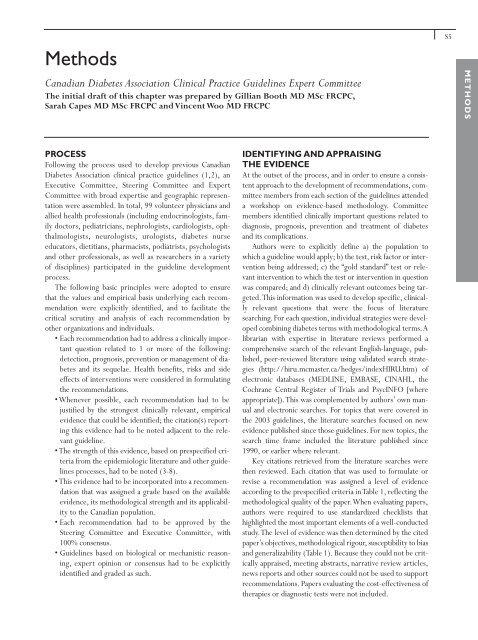2008 Clinical Practice Guidelines - Canadian Diabetes Association
2008 Clinical Practice Guidelines - Canadian Diabetes Association
2008 Clinical Practice Guidelines - Canadian Diabetes Association
You also want an ePaper? Increase the reach of your titles
YUMPU automatically turns print PDFs into web optimized ePapers that Google loves.
Methods<br />
<strong>Canadian</strong> <strong>Diabetes</strong> <strong>Association</strong> <strong>Clinical</strong> <strong>Practice</strong> <strong>Guidelines</strong> Expert Committee<br />
The initial draft of this chapter was prepared by Gillian Booth MD MSc FRCPC,<br />
Sarah Capes MD MSc FRCPC and Vincent Woo MD FRCPC<br />
PROCESS<br />
Following the process used to develop previous <strong>Canadian</strong><br />
<strong>Diabetes</strong> <strong>Association</strong> clinical practice guidelines (1,2), an<br />
Executive Committee, Steering Committee and Expert<br />
Committee with broad expertise and geographic representation<br />
were assembled. In total, 99 volunteer physicians and<br />
allied health professionals (including endocrinologists, family<br />
doctors, pediatricians, nephrologists, cardiologists, ophthalmologists,<br />
neurologists, urologists, diabetes nurse<br />
educators, dietitians, pharmacists, podiatrists, psychologists<br />
and other professionals, as well as researchers in a variety<br />
of disciplines) participated in the guideline development<br />
process.<br />
The following basic principles were adopted to ensure<br />
that the values and empirical basis underlying each recommendation<br />
were explicitly identified, and to facilitate the<br />
critical scrutiny and analysis of each recommendation by<br />
other organizations and individuals.<br />
• Each recommendation had to address a clinically important<br />
question related to 1 or more of the following:<br />
detection, prognosis, prevention or management of diabetes<br />
and its sequelae. Health benefits, risks and side<br />
effects of interventions were considered in formulating<br />
the recommendations.<br />
•Whenever possible, each recommendation had to be<br />
justified by the strongest clinically relevant, empirical<br />
evidence that could be identified; the citation(s) reporting<br />
this evidence had to be noted adjacent to the relevant<br />
guideline.<br />
• The strength of this evidence, based on prespecified criteria<br />
from the epidemiologic literature and other guidelines<br />
processes, had to be noted (3-8).<br />
• This evidence had to be incorporated into a recommendation<br />
that was assigned a grade based on the available<br />
evidence, its methodological strength and its applicability<br />
to the <strong>Canadian</strong> population.<br />
• Each recommendation had to be approved by the<br />
Steering Committee and Executive Committee, with<br />
100% consensus.<br />
• <strong>Guidelines</strong> based on biological or mechanistic reasoning,<br />
expert opinion or consensus had to be explicitly<br />
identified and graded as such.<br />
IDENTIFYING AND APPRAISING<br />
THE EVIDENCE<br />
At the outset of the process, and in order to ensure a consistent<br />
approach to the development of recommendations, committee<br />
members from each section of the guidelines attended<br />
a workshop on evidence-based methodology. Committee<br />
members identified clinically important questions related to<br />
diagnosis, prognosis, prevention and treatment of diabetes<br />
and its complications.<br />
Authors were to explicitly define a) the population to<br />
which a guideline would apply; b) the test, risk factor or intervention<br />
being addressed; c) the “gold standard” test or relevant<br />
intervention to which the test or intervention in question<br />
was compared; and d) clinically relevant outcomes being targeted.This<br />
information was used to develop specific, clinically<br />
relevant questions that were the focus of literature<br />
searching. For each question, individual strategies were developed<br />
combining diabetes terms with methodological terms.A<br />
librarian with expertise in literature reviews performed a<br />
comprehensive search of the relevant English-language, published,<br />
peer-reviewed literature using validated search strategies<br />
(http://hiru.mcmaster.ca/hedges/indexHIRU.htm) of<br />
electronic databases (MEDLINE, EMBASE, CINAHL, the<br />
Cochrane Central Register of Trials and PsycINFO [where<br />
appropriate]).This was complemented by authors’ own manual<br />
and electronic searches. For topics that were covered in<br />
the 2003 guidelines, the literature searches focused on new<br />
evidence published since those guidelines. For new topics, the<br />
search time frame included the literature published since<br />
1990, or earlier where relevant.<br />
Key citations retrieved from the literature searches were<br />
then reviewed. Each citation that was used to formulate or<br />
revise a recommendation was assigned a level of evidence<br />
according to the prespecified criteria in Table 1, reflecting the<br />
methodological quality of the paper.When evaluating papers,<br />
authors were required to use standardized checklists that<br />
highlighted the most important elements of a well-conducted<br />
study.The level of evidence was then determined by the cited<br />
paper’s objectives, methodological rigour, susceptibility to bias<br />
and generalizability (Table 1). Because they could not be critically<br />
appraised, meeting abstracts, narrative review articles,<br />
news reports and other sources could not be used to support<br />
recommendations. Papers evaluating the cost-effectiveness of<br />
therapies or diagnostic tests were not included.<br />
S5<br />
METHODS











